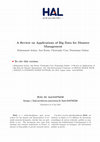inproceedings by Ana Roxin

ACM International Conference Proceeding Series, 2017
Working on a construction site is always risky because of its dynamic nature. Despite numerous ef... more Working on a construction site is always risky because of its dynamic nature. Despite numerous efforts to reduce fatalities on construction sites, fatal accidents continue to occur. The advancements in location acquisition and mobile communication techniques offer various means to monitor construction sites using mobility data. Information derived from such data offers tremendous opportunities to track and analyze the mobility of moving objects, that can contributes to improve safety management systems. However, such systems requires preprocessed positioning data of moving objects as raw data captured from location acquisition devices such as Global Positioning System (GPS) device is generally available as discrete points and do not hold enough information to understand the mobility. In this article, we have conducted a review of applications that use mobility data known as trajectories. After a detailed literature review, an application of trajectories carrying spatio-temporal information for worker safety on construction sites is discussed. The application collects GPS data and reconstructs workers trajectories using different data processing algorithms. Once trajectory data is cleaned and processed, it can further be enriched with semantic and contextual information to enable the desired interpretation of workers movements on construction sites and ultimately attempts to improve work zone safety by reducing fatalities. However, the scope of this paper is kept limited to data processing of GPS trajectories.

Proceedings of 13th IEEE International Conference on Signal-Image Technology and Internet-Based Systems (SITIS 2017), 2017
The term "disaster management" comprises both natural and man-made disasters. Highly pervaded wit... more The term "disaster management" comprises both natural and man-made disasters. Highly pervaded with various types of sensors, our environment generates large amounts of data. Thus, big data applications in the field of disaster management should adopt a modular view, going from a component to nation scale. Current research trends mainly aim at integrating component, building, neighborhood and city levels, neglecting the region level for managing disasters. Current research on big data mainly address smart buildings and smart grids, notably in the following areas: energy waste management, prediction and planning of power generation needs, improved comfort, usability and endurance based on the integration of energy consumption data, environmental conditions and levels of occupancy. This paper aims presenting a systematic literature review on the applications of big data in disaster management. The paper will first presents the visual definition of disaster management and describes big data; it will then illustrate the findings and gives future recommendations after a systematic literature review.
14th International Conference on Location Based Services (LBS 2018), Zurich, Switzerland, January 15-17, 2018, 2018
Open geospatial datasources like OpenStreetMap are created by a community of mappers of different... more Open geospatial datasources like OpenStreetMap are created by a community of mappers of different experience and with different equipment available. It is therefore important to assess the quality of OpenStreetMap-like maps to give recommendations for users in which situations a map is suitable for their needs. In this work we want to use already defined ways to assess the quality of geospatial data and apply them to a Machine Learning algorithm to classify which areas are likely to change in future revisions of the map. In a next step we intend to qualify the changes detected by the algorithm and try to find causes of the changes being tracked.
15th International Conference on Informatics in Economy (IE 2016), 2016
In the context of the globalisation, most companies changed the way in which they do business. No... more In the context of the globalisation, most companies changed the way in which they do business. Not only they have to be more reactive to changes in market forces, but they also need to be capable of adapting their business offers. To do so, companies have to collaborate mainly relying on Enterprise Information Systems (EIS) interoperability. EIS interoperability addresses problems related to the lack of system interoperability in organisations. In this paper, we focus on approaches which deliver semantic interoperability among these systems. We conclude by identifying the main drawbacks of such approaches to be adopted by world-wide industry and stating a future direction to solve these limits.

ISCRAM-med 2017: Information Systems for Crisis Response and Management in Mediterranean Countries, 2017
This position paper highlights current problems linked to the aspects of the multi-agency collabo... more This position paper highlights current problems linked to the aspects of the multi-agency collaboration during disaster response. The coordination and cooperation depend on the information sharing and use which must face up to interoperability, access rights, and quality problems. The research project aims at providing an assessment of information impact on the disaster response in order to support the decision-making about what information shared or what quality of data used to improve the response efficiency. Our research approach propose to combine an information system able to integrate heterogeneous data and a simulation system to assess different strategies of information sharing, dissemination and use. A knowledge base is used as a bridge between information system and simulation system. This knowledge base allows for designing dynamically a simulation according to open data and for managing the own knowledge and information known by each agent.

Proceedings of the 13th International Conference on Web Information Systems and Technologies (WEBIST), 2017
For several years, many researchers tried to semantically integrate geospatial datasets into the ... more For several years, many researchers tried to semantically integrate geospatial datasets into the semantic web. Although, there are many general means of integrating interconnected relational datasets (e.g. R2RML), importing schema-less relational geospatial data remains a major challenge in the semantic web community. In our project SemGIS we face significant importation challenges of schema-less geodatasets, in various data formats without relations to the semantic web. We therefore developed an automatic process of semantification for aforementioned data using among others the geometry of spatial objects. We combine Natural Language processing with geographic and semantic tools in order to extract semantic information of spatial data into a local ontology linked to existing semantic web resources. For our experiments, we used LinkedGeoData and Geonames ontologies to link semantic spatial information and compared links with DBpedia and Wikidata for other types of information. The aim of our experiments presented in this paper, is to examine the feasibility and limits of an automated integration of spatial data into a semantic knowledge base and to assess its correctness according to different open datasets. Other ways to link these open datasets have been applied and we used the different results for evaluating our automatic approach

32nd CIB W78 Conference on Information Technology in Construction, 2015
In the context of Building Information Modelling, ontologies have been identified as interesting ... more In the context of Building Information Modelling, ontologies have been identified as interesting in achieving information interoperability. Regarding the construction and facility management domains, several IFC (Industry Foundation Classes) based ontologies have been developed, such as IfcOWL. In the context of ontology modelling, the constraint of optimizing the size of IFC STEP-based files can be leveraged. In this paper, we propose an adaptation of the IFC model into OWL which leverages from all modelling constraints required by the object-oriented structure of IFC schema. Therefore, we do not only present a syntactic but also a semantic adaptation of the IFC model. Our model takes into consideration the meaning of entities, relationships, properties and attributes defined by the IFC standard. Our approach presents several advantages compared to other initiatives such as the optimization of query execution time. Every advantage is defended by means of practical examples and benchmarks.

eWork and eBusiness in Architecture, Engineering and Construction: ECPPM 2016: Proceedings of the 11th European Conference on Product and Process Modelling (ECPPM 2016), Sep 11, 2016
In the domain of Building Information Modelling (BIM), the open standardisation of methods for pr... more In the domain of Building Information Modelling (BIM), the open standardisation of methods for product and process modelling is undertaken by the buildingSMART association. Currently, buildingSMART recommends the use of Business Process Model and Notation (BPMN) for creating process models in Information Delivery Manuals (IDMs). This paper argues that BPMN is closely linked to the waterfall nature of today’s BIM projects, leading to a number of issues including long project durations, lack of stakeholder involvement, and disconnect of processes and data. Subject-oriented Business Process Management (S-BPM) is introduced as an alternative modelling approach for IDMs, based on its support for agile development that has the potential to address the above issues. Specifically, it is shown that S-BPM supports key concepts of agility, including stakeholder involvement, individual creativity, collaboration, rapid prototyping, and iterative design. The increased agility of S-BPM based IDM development can help make BIM projects faster, more flexible and better adapted to the needs of BIM users. including ill-defined execution semantics and high modelling complexity (Zhu et al. 2007; Börger 2012).
This paper argues that “subject-oriented” business process management (S-BPM)(Fleischmann et al. 2012) provides a more suitable approach for process modelling in the built environment. Originally developed in the mid-90s, S-BPM is now receiving growing attention from the academic community as well as from industrial companies worldwide. It differs from traditional process modelling methods such as BPMN in a number of aspects …
ECPPM 2016 (11 European Conference on Product and Process Modelling), 2016
Recent research in semantic web technologies for the built environment has resulted in several pr... more Recent research in semantic web technologies for the built environment has resulted in several proposals to further improve information exchange among stakeholders from the domain. Most notable is the production of several OWL ontologies that allow to capture building data in RDF graphs. For example, an ifcOWL ontology allows to capture IFC data in an RDF graph. As the building data is now available in a semantic graph with an explicit formal basis, it can be restructured and simplified so that it more easily matches the different requirements associated with practical use case scenarios. In this paper, we investigate several proposals and technological approaches to simplify ifcOWL building data, thus addressing the needs of specific industrial use cases.
4th Linked Data in Architecture and Construction Workshop (LDAC'2016), 2016
Over the last few years, the benefits of applying ontologies (semantic graph modelling) for Archi... more Over the last few years, the benefits of applying ontologies (semantic graph modelling) for Architecture, Engineering, Construction and Facility Management (AEC/FM) industry have been recognized by several researchers and industry stakeholders. One of the main motivations is because it eases AEC data manipulation and representation. However, a research question that still remains open is how to take advantage of semantic web technologies to interoperate the AEC/FM and other ontologies in a flexible and dynamical way in order to solve data structure heterogeneity problem. Because of this, we propose in this paper to apply a rule-based federated architecture to answer this research question.
buildingSMART International Standards Summit , 2016

Proceedings of the International Workshop on Semantic Big Data (SBD'16), 2016
The architectural design and construction domains work on a daily basis with massive amounts of d... more The architectural design and construction domains work on a daily basis with massive amounts of data. Properly managing, exchanging and exploiting these data is an ever ongoing challenge in this domain. This has resulted in large semantic RDF graphs that are to be combined with a significant number of other data sets (building product catalogues, regulation data, geometric point cloud data, simulation data, sensor data), thus making an already huge dataset even larger. Making these big data available at high performance rates and speeds and into the correct (intuitive) formats is therefore an incredibly high challenge in this domain. Yet, hardly any benchmark is available for this industry that (1) gives an overview of the kind of data typically handled in this domain; and (2) that lists the query and reasoning performance results in handling these data. In this article, we therefore present a set of available sample data that explicates the scale of the situation, and we additionally perform a query and reasoning performance benchmark. This results not only in an initial set of quantitative performance results, but also in recommendations in implementing a web-based system relying heavily on large semantic data. As such, we propose an initial benchmark through which new upcoming data management proposals in the architectural design and construction domains can be measured.

Proceedings of On the Move to Meaningful Internet Systems: OTM 2015 Conferences / ODBASE, 2016
Building Information Modelling (BIM) standards have been recognized by construction and political... more Building Information Modelling (BIM) standards have been recognized by construction and political actors as a highly promising tool for resolving issues of data dematerialization, notably in the field of Architecture, Engineering, Construction and Facility Management. Among worldwide-adopted BIM standards, there is COBie. COBie’s goals are to dematerialize building data and to enhance building information interoperability. Nevertheless, COBie data is available in static formats such as STEP or spreadsheet templates. Such formats lack logical formalisms and semantic features provided by languages such as OWL. Because of this, in this paper, we propose a method for semi-automatically conceiving an OWL ontology for the COBie standard starting from a COBie spreadsheet template. We call this ontology COBieOWL and we populate it directly from COBie spreadsheet data files as used by building actors. We also discuss various benefits of adopting our approach, for example: it reduces semantic heterogeneity of the COBie model. Besides, we discuss how COBieOWL can be linked to other LOD datasets such as FOAF.
14th International Conference on Informatics in Economy (IE 2015), 2015
In the field of AEC/FM, BIM has been recognized by industrial and political actors as a powerful... more In the field of AEC/FM, BIM has been recognized by industrial and political actors as a powerful tool for resolving data interoperability problems. Coupled with cloud computing and GIS, BIM would allow integrating different information exchange standard into one single digital building model that can be real-time edited by several stakeholders or architects. In this paper, we examine the benefits brought by using Semantic Web technologies in delivering such universal building model. We present how our approach is a step further in reaching the vision of BIM, and how it can serve construction process, operation and maintenance, along with facilities’ lifecycle management.

International Web Rule Symposium (RuleML 2015), 2015
The progress of information and communication technologies has greatly increased the quantity of ... more The progress of information and communication technologies has greatly increased the quantity of data to process. Thus, managing data heterogeneity is a problem nowadays. In the 1980s, the concept of a Federated Database Architecture (FDBA) was introduced as a collection of components to unite loosely coupled federation. Semantic web technologies mitigate the data heterogeneity problem, however due to the data structure heterogeneity the integration of several ontologies is still a complex task. For tackling this problem, we propose a loosely coupled federated ontology architecture (FOWLA). Our approach allows the coexistence of various ontologies sharing common data dynamically at query execution through logical rules. We have illustrated the advantages of adopting our approach through several examples and benchmarks. We also compare our approach with other existing initiatives.
14th International Conference on Informatics in Economy (IE 2015), 2015
Within the discussion about the analysis methods for Big Data contexts, semantic technologies of... more Within the discussion about the analysis methods for Big Data contexts, semantic technologies often get discarded for reasons of efficiency. While machine learning and statistics are known to have shortcomings when handling natural language, their advantages in terms of performance outweigh potential concerns. We argue that even when handling vast amounts of data, the usage of semantic technologies can be profitable and demonstrate this by developing an ontology-based system for automatically mapping user profiles to pre-defined marketing segments.
Proceedings of the 2013 International Conference on Developments in eSystems Engineering (DeSE), 2013
In this paper we present the concept and the implementation of an Active Semantic Learning System... more In this paper we present the concept and the implementation of an Active Semantic Learning System that takes advantage of the Social Semantic Web in order to deliver an efficient and personalized learning experience to the learner. Active participation of the learner is encouraged through the social learning approach and through techniques that adapt the learning content to learners' needs and preferences. The semantic layer allows us to define a common understanding of the data used to describe the objects in the learning system. The objects in the learning system are described using semantic web technologies. Domain ontologies and explicit logic rules are defined in order to allow data inferences and reasoning at the system level.

OTM 2014: On the Move to Meaningful Internet Systems: OTM 2014 Workshops, 2014
Personalization is the new magic buzzword of application development. To make the complexity of t... more Personalization is the new magic buzzword of application development. To make the complexity of today’s application functionalities and information spaces ”digestible”, customization has become the new go-to technique. But while those technologies aim to ease the consumption of media for their users, they suffer from the same problematic: in the age of Big Data, applications have to cope with a conundrum of heterogeneous information sources that have to be perceived, processed and interpreted. Researchers tend to aim for a maximum degree of integration to create the perfect, all-embracing personalization. The results are wide-range, but overly complex systems that suffer from issues in performance and scalability. Starting from our own, similar experience, we argue for a personalization of personalization - a clear-cut customization of profiling by limiting the information maintained in the system to those elements that are crucially relevant for the target task. We demonstrate the concern based on an application developed in our laboratory: a system that profiles web users based on their browsing history, with the goal of personalizing digital advertisements.

Proceedings of the RuleML 2014 Challenge and the RuleML 2014 Doctoral Consortium hosted by the 8th International Web Rule Symposium (RuleML 2014), 2014
In the area of building construction and management, the dematerialization of data and processes ... more In the area of building construction and management, the dematerialization of data and processes has been a global issue for the past 10 years. Going beyond the geometric representation of a building, Building Information
Modeling (BIM) is an approach that aims at integrating into one single system
heterogeneous data and processes from different actors. Such integration is a
complex and fastidious task. The implementation of the related processes for
data querying, retrieval or modification is not less difficult. To tackle this problem, we have developed a novel approach based on Semantic Web technologies. In doing so, we have defined an ontology inspired on IFC standard for representing building information. On top of this ontology, we have defined and
implemented a set of SWRL rules. The paper at hand describes these rules and
their application in the context of building information handling (notably by
means of IFC files).
Séminaire de Conception Architecturale Numérique, 2014
Dematerialization of all data and processes in the area of the building
is a global issue for the... more Dematerialization of all data and processes in the area of the building
is a global issue for the past 10 years. Beyond the simple geometric representation
of a building, BIM is imposed gradually as a complex cooperative
information system, integrating with difficulty the data and heterogeneous practices
of different actors of the domain. Integrated retrieval of these data to the
building users is tricky. In order to solve this problem, we use a semantic representation
approach of the building and particularly of the IFC standard. This
approach allows to extract valid partial IFC files from an IFC file modeling the
entire building.











Uploads
inproceedings by Ana Roxin
This paper argues that “subject-oriented” business process management (S-BPM)(Fleischmann et al. 2012) provides a more suitable approach for process modelling in the built environment. Originally developed in the mid-90s, S-BPM is now receiving growing attention from the academic community as well as from industrial companies worldwide. It differs from traditional process modelling methods such as BPMN in a number of aspects …
Modeling (BIM) is an approach that aims at integrating into one single system
heterogeneous data and processes from different actors. Such integration is a
complex and fastidious task. The implementation of the related processes for
data querying, retrieval or modification is not less difficult. To tackle this problem, we have developed a novel approach based on Semantic Web technologies. In doing so, we have defined an ontology inspired on IFC standard for representing building information. On top of this ontology, we have defined and
implemented a set of SWRL rules. The paper at hand describes these rules and
their application in the context of building information handling (notably by
means of IFC files).
is a global issue for the past 10 years. Beyond the simple geometric representation
of a building, BIM is imposed gradually as a complex cooperative
information system, integrating with difficulty the data and heterogeneous practices
of different actors of the domain. Integrated retrieval of these data to the
building users is tricky. In order to solve this problem, we use a semantic representation
approach of the building and particularly of the IFC standard. This
approach allows to extract valid partial IFC files from an IFC file modeling the
entire building.
This paper argues that “subject-oriented” business process management (S-BPM)(Fleischmann et al. 2012) provides a more suitable approach for process modelling in the built environment. Originally developed in the mid-90s, S-BPM is now receiving growing attention from the academic community as well as from industrial companies worldwide. It differs from traditional process modelling methods such as BPMN in a number of aspects …
Modeling (BIM) is an approach that aims at integrating into one single system
heterogeneous data and processes from different actors. Such integration is a
complex and fastidious task. The implementation of the related processes for
data querying, retrieval or modification is not less difficult. To tackle this problem, we have developed a novel approach based on Semantic Web technologies. In doing so, we have defined an ontology inspired on IFC standard for representing building information. On top of this ontology, we have defined and
implemented a set of SWRL rules. The paper at hand describes these rules and
their application in the context of building information handling (notably by
means of IFC files).
is a global issue for the past 10 years. Beyond the simple geometric representation
of a building, BIM is imposed gradually as a complex cooperative
information system, integrating with difficulty the data and heterogeneous practices
of different actors of the domain. Integrated retrieval of these data to the
building users is tricky. In order to solve this problem, we use a semantic representation
approach of the building and particularly of the IFC standard. This
approach allows to extract valid partial IFC files from an IFC file modeling the
entire building.
Highlights:
•A semantic web based method is provided to extract building model views.
•Several possible improvements to the ifcOWL ontology are presented.
•Our approach generates valid partial IFC STEP files according to a given business context.
•Several open BIM models are used to evaluate our approach.
•Performance issues and possible improvements are discussed.
advertising space (“real-time bidding”), user profiling from web navigation traces
becomes crucial. Indeed, it allows online advertisers to target customers without
interfering with their activities. Current techniques apply traditional methods as
statistics and machine learning, but suffer from their limitations. As an answer, the
proposed approach aims to develop and evaluate a semantic-based user profiling
system for digital advertising